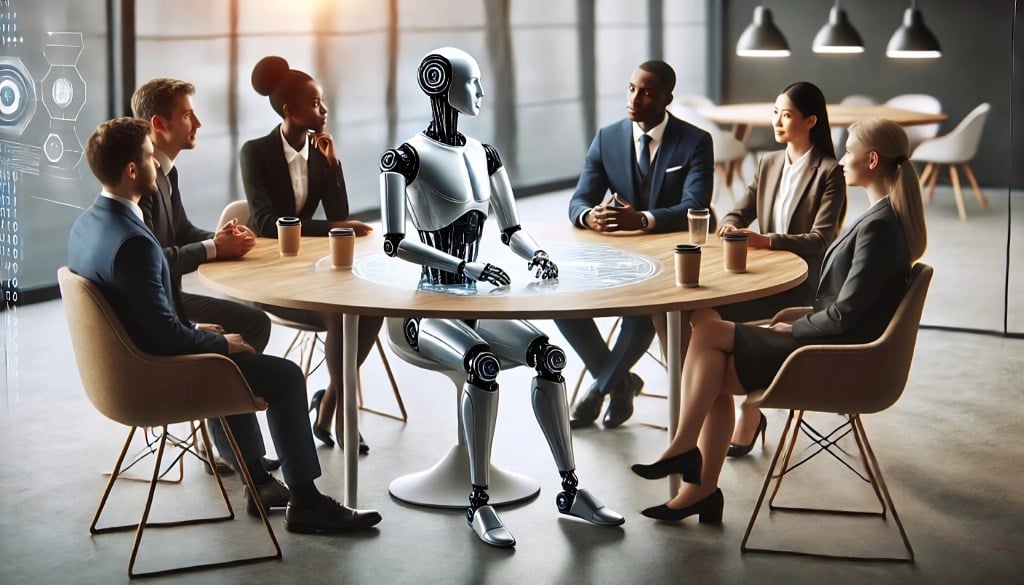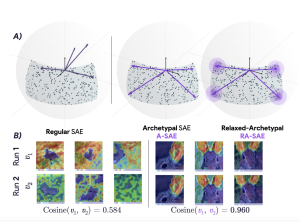Onboarding the AI workforce: How digital agents will redefine work itself

Join our daily and weekly newsletters for the latest updates and exclusive content on industry-leading AI coverage. Learn More
AI is rapidly evolving, poised to transform the workplace in ways that were thought of as science fiction only a few years ago. For example, Google recently updated its NotebookLM, an AI-powered research assistant and note-taking tool, with Audio Overview to turn documents into audio discussions. Writing in ArsTechnica, Kyle Orland describes how he used this feature to create a “disarmingly compelling” 12.5-minute podcast-style conversation about a book he had written. The conversation was “between two people who don’t exist.”
This highlights a broader trend of AI evolving to replicate human-like behaviors — a development that will soon reshape how businesses work, and how workers engage with technology.
NotebookLM uses Google’s Gemini gen AI large language model (LLM) and pairs it with its recent AI-generated voice capability. Discussing how well this works, Graham Barlow writes in TechRadar: “[The bots] talk with passion and authority about the subject, sound engaged and interested and riff off one another in such a natural way that it takes your breath away. There are even the little sniffs, slight mispronunciations, slurs and little giggles that all make it sound completely human.”
This is just one of the many ways that the AI revolution is taking shape.
Challenges with AI remain, including hallucinations and inherent biases in training data. As these issues lessen or ideally are resolved, the role of AI will expand from automating simple tasks to reshaping how work is done, how businesses run and how employees interact with technology.
From AI-driven decision-making to immersive customer experiences increasingly powered by digital humans (synthetic creations that emulate humans in their on-device appearance, mannerisms and voice), the future of work will be more efficient, more creative and perhaps more human-centered than we can currently imagine. Here are some of the changes that are coming.
AI in 2030: A transformative force
1. AI agents are integral team members
By 2030, AI agents will be fully integrated into enterprise operations, serving as collaborative team members rather than simple task handlers. An AI agent is a software entity that autonomously completes tasks and, increasingly, coordinates with other agents to achieve complex goals, often using machine learning or rule-based systems.
Today’s AI systems help improve processes, but their future lies in taking over more complex roles. In sectors such as customer service, logistics and project management, AI agents will manage routine tasks, while providing human workers with real-time insights and analysis. With its ability to handle complex tasks, the new “o1” model from OpenAI will further advance this capability.
2. The emergence of digital humans
Digital humans (lifelike, AI-powered avatars that can interact in real time) have begun to make their mark in customer service and sales, and their impact will be profound by 2030. Equipped with highly realistic facial expressions, natural language processing (NLP) and human-like speech, these avatars will function as front-line customer service agents, onboarding specialists, inside sales representatives or even virtual brand ambassadors.
For instance, when customers interact with a brand’s website or call center in 2030, they might be greeted by a digital human capable of understanding their needs, recalling past interactions and resolving issues with an intuitive, conversational approach. This could be a major improvement over the numbing or even infuriating customer support most of us routinely experience today.
Unlike current AI chatbots, these systems will feel less transactional and more like human-to-human communication. That said, as AI systems become indistinguishable from human interaction, companies will need to clearly show when AI is involved to support transparency and trust in customer relationships. My guess is that most people will be happy to interact with an AI if it means getting their issue resolved with less friction.
3. AI-driven speech and conversational interfaces
By 2030, fully human-sounding, interactive speech will be ubiquitous in customer service, internal meetings and even creative brainstorming sessions. AI-powered voices will be indistinguishable from human ones, capable of holding fluid, natural conversations. As reported last week in VentureBeat, the newly available ChatGPT Advanced Voice Mode with nine different voices is an early instance of this capability.
With this advancement and others including from startup Hume, AI systems will begin to seamlessly integrate into daily operations, guiding customers through processes, answering complex questions and even participating in meetings as conversational partners. A recent headline in Tom’s Guide sums up this capability: “I just had a conversation with Hume’s new AI voice assistant — and I forgot it wasn’t human.”
4. AI-enhanced decision-making and leadership
As AI-powered digital humans enhance customer interactions by emulating human behavior, the broader impact of AI will be seen in how it reshapes decision-making across organizations, offering leaders real-time insights and strategic support. AI will not just streamline tasks — it will provide executives with real-time dashboards, predictive analytics and scenario-planning capabilities that help leaders make data-driven decisions faster and more effectively. In this context, AI becomes not only a tool but an advisor—able to offer insights that guide strategy.
For example, AI-powered digital assistants could sit in on leadership meetings, offering real-time suggestions or running simulations based on ongoing discussions. Some companies have already appointed AI bots as observers to their boards and are putting tech at the center of their board strategy work.
5. Innovation and research powered by AI
Within the next couple of years, AI-driven simulations and predictive modeling will be critical to testing new products, business models and market strategies. This is already being done in the form of digital twins, but increasingly enterprises will rely on AI to gather insights, predict trends and refine prototypes before they enter production.
AI will also enhance creativity and collaboration. In brainstorming sessions, for instance, AI systems will suggest ideas drawn from massive datasets and global trends, helping human teams unlock new insights. Combined with digital humans or AI-driven conversational interfaces, teams will be able to engage in dynamic, cross-disciplinary discussions that push the boundaries of innovation.

6. The changing nature of job roles and skills
As AI takes over routine and data-heavy tasks, the nature of job roles will shift toward oversight, creativity and human-centered skills. AI trainers, ethics officers and AI maintenance professionals will be critical in ensuring that AI systems run effectively and ethically. These are some of the new jobs that will be created as AI becomes more ubiquitous at work. Continuous reskilling will become the norm, as workers adapt to rapid advancements in AI technology.
Human abilities such as creativity, critical thinking and emotional intelligence will remain irreplaceable. AI may manage the analysis and data, but humans will need to drive strategic vision, ethical considerations and empathetic customer interactions.
To fully realize AI’s potential while mitigating its risks, businesses must invest not only in the technology itself but in robust AI governance frameworks and continuous reskilling programs to ensure both ethical use and a workforce that can effectively collaborate with AI systems.
Preparing for the AI-driven future
Just as Google’s NotebookLM and OpenAI’s Advanced Voice Mode shows AI’s increasing ability to emulate human behaviors, the coming years will see enterprises harnessing these technologies in ways that reshape industries. In the view of venture firm Sequoia Capital: “Every industry that requires humans to create original work — from social media to gaming, advertising to architecture, coding to graphic design, product design to law, marketing to sales — is up for reinvention.”
Companies at the vanguard of AI adoption are now widely implementing the technology. For example, HBR reported that Moderna’s deployment of ChatGPT has led to more than 750 custom GPTs developed across business functions, with each user averaging 120 ChatGPT enterprise conversations per week. Companies that delay using AI risk falling behind in both innovation and competitiveness.
By 2030, AI will have evolved from a back-office assistant to a front-line collaborator in most companies and in nearly every aspect of enterprise operations. Workers who embrace AI as a partner, rather than a competitor, will thrive in this new environment.
A major ongoing concern is the potential for replacing human employees with AI. One group of employees thought to be particularly at risk is entry-level white-collar workers. However, a new poll of more than 2,100 interns at investment banker Goldman Sachs points in the opposite direction. As reported by Quartz, nearly all — 93% —of the investment bank’s latest interns believe AI will enhance their work, not replace it.
A common but applicable refrain now is “AI won’t replace employees, however, employees who use AI will replace those who don’t use AI.” As proof, Microsoft and LinkedIn’s 2024 Work Trend Index found that 71% of business leaders would rather hire a less experienced candidate with AI skills than a more experienced candidate without them.
For businesses, this means actively investing in reskilling initiatives and establishing strong AI governance to ensure that AI not only boosts productivity but also aligns with ethical standards and enhances customer trust. Strong AI governance will require clear accountability for AI-driven decisions, safeguards against bias and strict adherence to data privacy standards to support trust and transparency. IBM offers a good example. The company has set up comprehensive frameworks that emphasize accountability, bias mitigation and data privacy, fostering trust and transparency in its AI-driven outputs.
On the precipice of change
As we stand on the cusp of this AI-driven future, the workplace of 2030 will be radically different from today’s. From AI agents and digital humans revolutionizing customer interactions to AI-enhanced decision-making reshaping leadership, the potential for transformation is immense.
Yet, the true power of this revolution lies not in AI replacing humans, but in the symbiosis between human creativity and AI. The organizations and individuals who thrive in this new landscape will be those who embrace AI as a partner, continuously adapt their skills and leverage technology to amplify their human potential.
Gary Grossman is EVP of the technology practice at Edelman.
DataDecisionMakers
Welcome to the VentureBeat community!
DataDecisionMakers is where experts, including the technical people doing data work, can share data-related insights and innovation.
If you want to read about cutting-edge ideas and up-to-date information, best practices, and the future of data and data tech, join us at DataDecisionMakers.
You might even consider contributing an article of your own!
Read More From DataDecisionMakers








